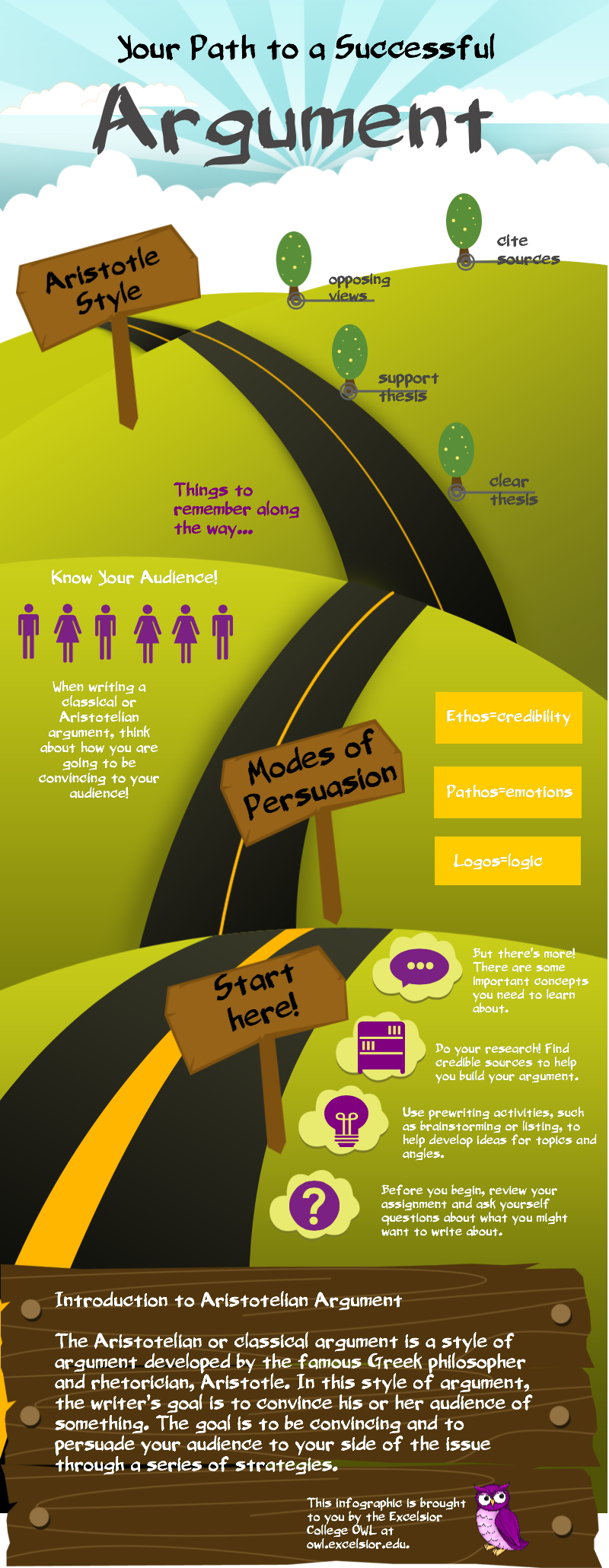Aristotelian Argument
The Aristotelian or classical argument is a style of argument developed by the famous Greek philosopher and rhetorician, Aristotle. In this style of argument, your goal as a writer is to convince your audience of something. The goal is to use a series of strategies to persuade your audience to adopt your side of the issue. Although ethos, pathos, and logos play a role in any argument, this style of argument utilizes them in the most persuasive ways possible.
Of course, your professor may require some variations, but here is the basic format for an Aristotelian, or classical, argumentative essay:
- Introduce your issue. At the end of your introduction, most professors will ask you to present your thesis. The idea is to present your readers with your main point and then dig into it.
- Present your case by explaining the issue in detail and why something must be done or a way of thinking is not working. This will take place over several paragraphs.
- Address the opposition. Use a few paragraphs to explain the other side. Refute the opposition one point at a time.
- Provide your proof. After you address the other side, you’ll want to provide clear evidence that your side is the best side.
- Present your conclusion. In your conclusion, you should remind your readers of your main point or thesis and summarize the key points of your argument. If you are arguing for some kind of change, this is a good place to give your audience a call to action. Tell them what they could do to make a change.
Aristotelian Infographic

-
Information Contained Within the Infographic
Introduction to Aristotelian Argument
The Aristotelian or classical argument is a style of argument developed by the famous Greek philosopher and rhetorician, Aristotle. In this style of argument, the writer’s goal is to be convincing and to persuade your audience to your side of the issue through a series of strategies.
Start here!
Before you begin, review your assignment and ask yourself questions about what you might want to write about.
Use prewriting activities, such as brainstorming or listing, to help develop ideas for topics and angles.
Do your research! Find credible sources to help you build your argument.
But there’s more! There are some important concepts you need to learn about.
Modes of Persuasion
Ethos=credibility
Pathos=emotions
Logos=logic
Know Your Audience!
When writing a classical or Aristotelian argument, think about how you are going to be convincing to your audience!
Things to remember along the way…
Clear thesis
Support thesis
Opposing views
Cite sources
Sample Aristotelian Argument
Now that you have had the chance to learn about Aristotle and a classical style of argument, it’s time to see what an Aristotelian argument might look like. Below, you’ll see a sample argumentative essay, written according to APA 7th edition guidelines, with a particular emphasis on Aristotelian elements.
Download here the sample paper. In the sample, the strategies and techniques the author used have been noted for you.
This content was originally created by Excelsior Online Writing Lab (OWL) and is licensed under a Creative Commons Attribution-4.0 International License. You are free to use, adapt, and/or share this material as long as you properly attribute. Please keep this information on materials you use, adapt, and/or share for attribution purposes.
















